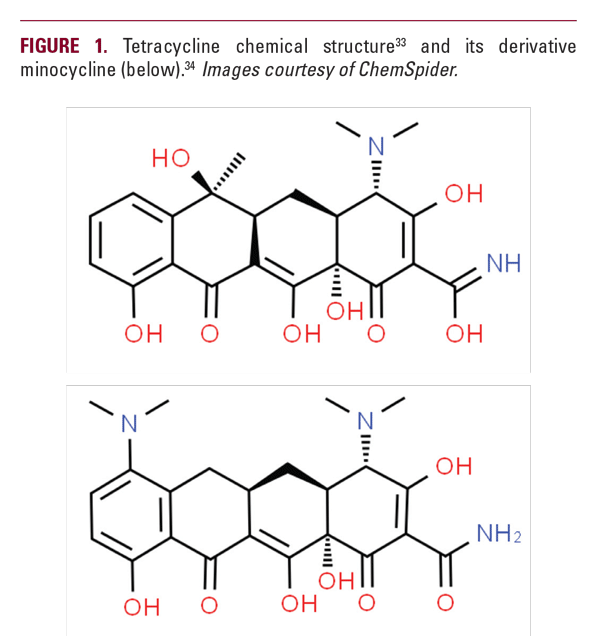
use of the TCN agents includes: limiting indiscriminate and long term use, having an exit strategy, and concomitant use of a topical agent such as benzoyl peroxide (BP) to optimize therapeutic efficacy and help prevent C. acnes resistance.19,24 Oral antibiotics are not to be used as monotherapy in acne vulgaris,20,25 and the addition of topicals such as a retinoid or retinoid plus BP may help to successfully limit antibiotic use to 3–4 months or less.20
Among the TCN derivatives with available clinical trials and data, there is no evidence of clinical superiority of one drug over the other. However, there is considerable difference between the agents in terms of tolerability and safety, development of resistance, delivery systems, and administration recommendations. Knowledge of all these agents is required to make the best choice for each individual patient.
Doxycycline
Doxycycline was the first TCN derivative to come to market in 1967 and is most commonly prescribed for acne vulgaris. Relative to TCN, it is more lipophilic and better able to penetrate and accumulate in the sebaceous glands. It is available in two formulations that are both salt forms of the same drug: hyclate and monohydrate. In general, doxycycline hyclate is more likely to cause GI side effects, but these effects can be mitigated by buffering.26,27 Doxycycline is dosed once or twice daily, and absorption is decreased by co-administration with food (especially dairy), although the clinical significance of this characteristic in acne is unknown.28
The side effect profile of doxycycline is improved compared to its parent TCN. However, there are still several potential adverse reactions, most of which can be minimized with proper precautions. GI distress is common, but is lessened with buffered formulations, delayed-release formulations, and administration with food. Pill esophagitis can be avoided by taking with a large glass of water and remaining in the upright position for 30–60 minutes.29 Photosensitivity is common, particularly with higher daily doses, but is preventable with the use of photoprotection.
Sarecycline
New to the TCN class is sarecycline, which was approved by the FDA in 2018 for the treatment of inflammatory lesions of non-nodular moderate to severe acne vulgaris.30 Compared to minocycline and doxycycline, sarecycline has been shown to have 16–32 fold less activity against anaerobic gram-negative gut flora including E. coli, K. pneumoniae and E. cloacae.32 As a result, it may cause less emergence of antibiotic resistance than other tetracyclines.31 Recently, it was shown that C. acnes strains displayed a low propensity for the development of resistance to sarecycline, with spontaneous mutation frequency being 10-10 at 4–8 X MIC. The clinical relevance of this finding has yet to be explored.32
Sarecycline is weight-based, aiming for 1.5 mg/kg/day. It is dosed once daily, can be taken with or without food, and is the only oral tetracycline derivative FDA-approved down to 9 years of age. In its clinical trials, GI side effects were uncommon, and photosensitivity, drug hypersensitivity syndromes, and esophagitis were not reported.31,32 It must be noted, however, that the drug is in its infancy compared to the other TCN derivatives.
Minocycline
7-dimethylamino-6-demethyl-6-deoxytetracycline (MCN)35 is a semi-synthetic, second-generation of the TCN class,36 and is the most lipophilic of the TCN derivatives.37 This lipophilicity affords high concentrations within the lipid-filled pilosebaceous unit, the anatomical location for acne pathophysiology.20 In addition to being strongly anti-microbial against C. acnes, numerous anti-inflammatory mechanisms address the inflammatory nature of the disease.38,39 These mechanisms include reducing lipid peroxidation and proinflammatory cytokines, decreasing neutrophil chemotaxis, and resulting reactive oxygen species, inhibition of phospholipase A2 and subsequent arachidonic acid metabolites, as well as suppressing matrix metalloproteinases and nitric oxide.16,40-42
MCN has a long half-life, and excellent absorption that is not substantially impaired by food (dairy included).28 It is dosed once daily, with or without meals. These two factors may increase the likelihood of compliance in acne vulgaris, a disease whose treatment is commonly fraught with adherence difficulties.43






